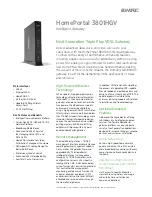
LTE910XF v6.00 CAT 1 Hardware User Guide JA20-UM-LTE-C1_v6 Page 5 Rev: 02 Date: 09/07/18
© Copyright 2018 Janus Remote Communications
Specifications subject to change without notice
All Rights Reserved See website for latest revision. Not intended for life support applications.
2. TECHNICAL SPECIFICATIONS continued
2.1 Electrical Specifications
2.1.2 Recommended Ratings & Module Pin out
2.1.2.1 Connectors J1 and J2 continued....
Pin
Name
Direction Description
Min
Typical
Max
If not used
16
RTS
Input
Modem Request to Send hardware
VIL:
VIH:
flow control input
GND to
VREF-0.4 Tie to GND
0.15V
V to VREF
17
DIO3
I/O
Programmable GPIO_03 on
Telit module
0
1.8V
No connection
18
DIO2
I/O
Programmable GPIO_02 on
Telit module
0
1.8V
No connection
19
ADC1
Input
ADC_IN1 input on Telit module
(10bit resolution, <1.2mV)
0
1.2V
No connection
Modem On/Off signal. Assert low for
at least 5 seconds and then release to
activate start sequence. Drive with
20
ON_OFF
Input
open collector output. Internally
0
1.8V
Must be implemented
pulled up to internal I/O rail with pull
up. Do not use any external pull ups.
Note: If you want modem to turn on
automatically when power is applied,
permanently tie this signal to GND.
2.1.2.2 Connectors P4, P1, P2
Connector Designator
Description
Connector Location
P4
Micro SIM Connector
Bottom Side of Module
P1
Primary Antenna Connection
Topside of Module
P2
Secondary Antenna Connection
Topside of Module
2.1.2.3 Power Consumption
1, 2
Mode
Network
Average Current (mA)
Notes
Idle modes
Off
1
TX/RX disabled
+CFUN=4
n/a
12
Not registered on network
Idle
+CFUN=1
LTE
14
Normal mode, full function
Power Saving
+CFUN=5
LTE
6.8
0.32s DRx
Power Saving
+CFUN=5
LTE
4.5
0.64s DRx
Power Saving
+CFUN=5
LTE
3
1.28s DRx
Power Saving
+CFUN=5
LTE
2.8
2.56s DRx
Operative Modes
Data call
LTE
190
Tx=0dBm
Data call
Maximum power
LTE
500
Tx=22dBm
Note 1: These figures are derived from the component data sheets including the Telit Hardware User Guide. Per Telit, “The reported values are an
average among all the product variants and bands for each network wireless technology.” Results can vary depending network conditions.
Note 2: Power consumption figures are with on-board Status LED disabled.






























